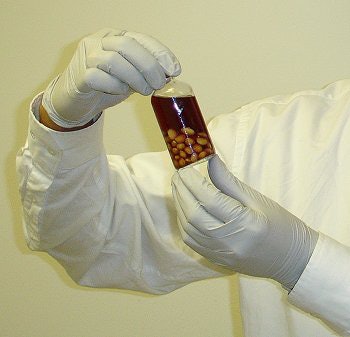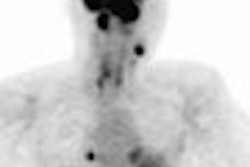
A group of researchers at the University of Missouri-Columbia (UM) has developed a method of using natural ingredients to produce gold nanoparticles for the diagnosis and treatment of cancerous tumors.
Columbia, MO-based researchers Kattesh Katti, Ph.D.; Raghuraman Kannan, and Kavita Katti, a senior research chemist, lead a team of scientists who have created a process to make gold nanoparticles using gold salts, soybeans, and water. No other manmade or potentially toxic chemicals are used.
Traditionally, various synthetic chemicals are needed to create gold nanoparticles. Some manmade chemicals, such as sodium borohydride, while proficient in the production of gold nanoparticles, are toxic to cells and humans.
"We did not want to use such harsh chemicals, so we researched and succeeded in the discovery of soybeans," said Katti, professor of radiology and physics in UM's School of Medicine and director of the University of Missouri Cancer Nanotechnology Platform. "Soybeans have certain vital chemicals in them, which have reducing properties. These chemicals in soybeans have very similar properties to other chemicals, such as sodium borohydride. Sodium borohydride converts gold salt into nanoparticles. The chemicals within soybeans do the same -- perhaps even better -- and soybeans are harmless."
The research began about six years ago after the University of Missouri Cancer Nanotechnology Platform received a grant from the National Institutes of Health for $3.2 million. Researchers eventually discovered that by submersing gold salts in water and then adding soybeans, gold nanoparticles were generated.
Katti presented the work at the 2007 National Cancer Institute Alliance for Nanotechnology in Cancer Investigators meeting in San Diego and 4th International Congress of Nanotechnology and Clean Tech World Congress 2007 in San Francisco.
Nanoparticle production
Water extracts a phytochemical from the soybean that is effective in reducing the gold to nanoparticles. A second phytochemical from the soybean, also extracted by the water, then interacts with the nanoparticles to stabilize them and keep them from fusing with other nearby particles. The process creates nanoparticles that are uniform in size through a completely natural process.
 |
| Gold salt, soybeans, and water combine to produce the gold nanoparticles. Image courtesy of Kattesh Katti, Ph.D., and the University of Missouri-Columbia. |
So far, one radiological application that has a proof-of-concept in animals is in the contrast of healthy and cancerous tissue, according to Kattie. The gold nanoparticles enhance that contrast for a clear distinction between cancerous and noncancerous tissue.
After injection, low-energy x-rays detect the cancerous tumor, followed by high-energy x-ray for treatment. The gold nanoparticles have proved effective in both diagnosis and therapy.
"We localize the nontoxic gold nanoparticles around the tumor site, then hit that site with high-energy x-rays," Katti noted. "By doing so, only the places where there is a nanoparticle population will absorb that high energy. We make sure that those nanoparticles are targeted specifically around the tumor site; therefore, the healthy tissue is spared from high-energy radiation."
Additional testing
The researchers plan to test the efficacy of the gold nanoparticles to treat other diseases, using small and large animals, such as mice and pigs. The study is ongoing and Katti described the results so far as "highly encouraging."
He expects that it will be several years before human trials with the soybean-based gold nanoparticles can be performed. Because the process uses no external chemicals, other than the gold salt, he believes the approval process "may go very rapidly."
"Normally, the issues are, as the number of chemicals of chemical ingredients in drug development goes up, you have to do more testing to show that particular drug formula has no toxicity," Katti said. "The chemicals that we use for our process are the ones that are ingested on a daily basis by all human beings and animals."
Having a completely natural process for gold nanoparticle production also could allow medical researchers to expand their use of the nanoparticles. With nanotechnology expected to produce large quantities of nanoparticles in the near future, there have been concerns about the environmental impact.
Production of the gold nanoparticles also is "very feasible," he added, in part, because the process leaves no toxic byproducts. With U.S. farmers producing billions of bushels of soybeans annually, supply likely will not be an issue either.
Longer durability
UM researchers also are developing a natural way to extend the lifespan of the gold nanoparticles. The process uses plant extracts without chemicals to keep the gold nanoparticles intact for an extended period of time. "They can be stored and shipped to any corner of the world," Katti added. "I think we can popularize this field of nanomedicine, regardless of the geographic origin."
Katti, Kannan, Kavita Katti, and Henry White, a MU professor of physics, have filed a patent for the new process and developed a new company called Greennano, which focuses on the development, commercialization, and worldwide supply of green nanoparticles for medical and technological applications.
By Wayne Forrest
AuntMinnie.com staff writer
December 7, 2007
Related Reading
Gold marker implants for prostate radiotherapy safe, study finds, November 20, 2007
New PET tracer may improve atherosclerotic imaging, November 15, 2007
SUNY Buffalo developing multimodality nanoparticles, October 6, 2006
Imaging's big future gets smaller, July 3, 2006
Image guidance evolves into imaging therapy, May 12, 2006
Copyright © 2007 AuntMinnie.com



















